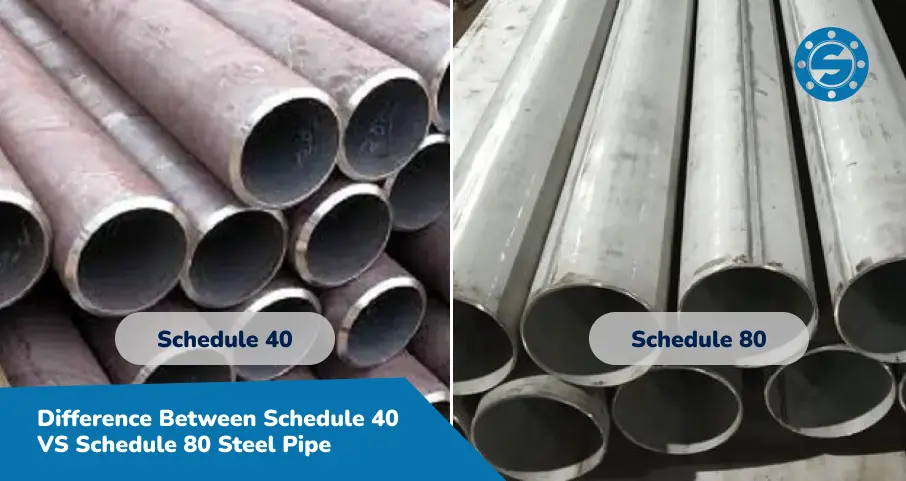Difference Between Schedule 40 VS Schedule 80 Steel Pipe

What is a Pipe Schedule?
A pipe schedule (SCH) is a standardized way to describe the wall thickness of a pipe, though it isn’t an actual physical measurement. Pipes can have the same outside diameter but different schedule numbers, which indicate varying wall thicknesses. The schedule number helps determine the strength and pressure capacity of the pipe.
To identify the right pipe for a specific application, you would typically refer to a Pipe Schedule Chart, which shows the nominal pipe size along with the corresponding schedule number. This combination makes it easier to choose pipes that meet the necessary requirements for pressure, flow rate, and structural stability in various applications.
What’s the Difference Between Schedule 40 and Schedule 80 ?
Pipe is available in two common varieties: Schedule 40 and Schedule 80. While both types might look similar at first glance, they have important differences that affect their use in different applications.
The primary difference between Schedule 40 and Schedule 80 pipes lies in the wall thickness. Schedule 40 pipes have thinner walls, making them ideal for low-pressure applications such as residential plumbing. These pipes are typically white but can sometimes be gray. Due to their thinner walls, they are less expensive but also less capable of handling high-pressure situations.
On the other hand, Schedule 80 pipes have thicker walls, enabling them to withstand higher pressures. This makes them better suited for industrial and chemical applications where the pipe must endure more demanding conditions. Schedule 80 pipes are usually gray, though they can occasionally be white. The thicker walls of Schedule 80 pipes result in a slightly smaller inner diameter, which can restrict flow compared to Schedule 40 pipes. However, this increased thickness also means that Schedule 80 pipes are more resistant to bending and breaking.
Both Schedule 40 and Schedule 80 pipes share the same outer diameter, meaning they can use the same fittings. However, it’s crucial to remember that the overall pressure capacity of a pipeline is determined by its weakest component. Using a Schedule 40 fitting with a Schedule 80 pipe lowers the system’s maximum PSI, potentially compromising its integrity under high pressure.
When choosing between Schedule 40 and Schedule 80 pipes, consider the specific requirements of your project. For standard plumbing or irrigation systems, Schedule 40 pipes are typically sufficient and more budget-friendly. However, for industrial or chemical applications that involve higher pressures, Schedule 80 pipes are a better investment due to their durability and strength.
Schedule 40 vs Schedule 80 PVC
| Feature | Schedule 40 PVC Pipe | Schedule 80 PVC Pipe |
| Wall Thickness | Thinner | Thicker |
| Pressure Rating | Lower | Higher |
| Durability | Less durable | More durable |
| Cost | Less expensive | More expensive |
| Common Applications | Residential plumbing, irrigation systems, drain-waste-vent systems, low-pressure applications | Industrial processes, hydraulic systems, underground piping, high-pressure applications |
Key Differences sch 40 vs sch 80
Schedule 40:
– Cost: Less expensive
– Usage: Suitable for residential plumbing and irrigation
– Wall Thickness: Thinner walls (0.154” on a 2” nominal pipe)
– Pressure Rating: Can handle up to 280 PSI
– Color: Typically white, but can vary
Schedule 80:
– Cost: Slightly more expensive
– Usage: Primarily for chemical, industrial, and manufacturing applications
– Wall Thickness: Thicker walls (0.218” on a 2” nominal pipe)
– Pressure Rating: Can handle up to 400 PSI
– Color: Usually gray, but may also be white
Major Difference - Schedule 40 vs Schedule 80 Pipe
Pressure:
NPS and Inner Diameter
Both Schedule 40 and Schedule 80 pipes have the same outer diameter (OD) for a given Nominal Pipe Size (NPS). However, the main difference lies in the inner diameter (ID). Schedule 80 pipes have thicker walls, reducing the inner diameter compared to Schedule 40 pipes. This reduction in ID can slightly lower fluid flow rates, but the thicker walls of Schedule 80 provide greater durability and safety, especially in pressurized applications.
Cost
Schedule 40 pipes are generally more affordable than Schedule 80 due to their thinner walls, which require less material. The added material and sometimes additional colorant in Schedule 80 pipes make them more expensive. While Schedule 40 is cost-effective, Schedule 80 offers extra strength and is the better choice for high-pressure or demanding applications.
Color
Schedule 40 pipes are typically white, while Schedule 80 pipes are usually gray. However, color is not a definitive way to identify pipe schedules, as some manufacturers may use different colors. Always check the printed information on the pipes to confirm the schedule, as relying solely on color can be misleading.
Installation:
Installing Schedule 40 and Schedule 80 pipes made from the same material follows the same process. Since the outer diameters are identical for the same NPS, these pipes can be joined using standard fittings and methods. Proper installation is crucial for ensuring a safe and efficient plumbing system, regardless of the schedule.
Application:
Schedule 80 pipes are stronger and more durable than Schedule 40 pipes due to their thicker walls, making them suitable for applications involving high pressure, mechanical stress, or chemical exposure. When choosing between Schedule 40 and Schedule 80, consider the specific requirements and potential stresses in your application to ensure you select the appropriate pipe schedule.
Summary
Pipe scheduling refers to the numbering system that indicates the thickness of a steel pipe’s wall. A higher schedule number means thicker walls, which translates to stronger pipes capable of handling greater fluid pressures. Schedule 80 pipes, with their thicker walls, are stronger and more durable compared to Schedule 40 pipes, but this also makes them more expensive. Schedule 40 pipes, being of standard weight, are more commonly used in construction and general applications. In contrast, Schedule 80 pipes are preferred in situations where the pipes need to withstand high pressure or temperature, making them ideal for more demanding environments.


